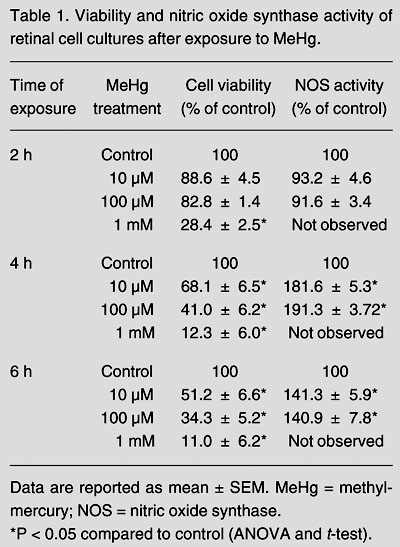The visual system is a potential target for methylmercury (MeHg) intoxication. Nevertheless, there are few studies about the cellular mechanisms of toxicity induced by MeHg in retinal cells. Various reports have indicated a critical role for nitric oxide synthase (NOS) activation in modulating MeHg neurotoxicity in cerebellar and cortical regions. The aim of the present study is to describe the effects of MeHg on cell viability and NOS activation in chick retinal cell cultures. For this purpose, primary cultures were prepared from 7-day-old chick embryos: retinas were aseptically dissected and dissociated and cells were grown at 37ºC for 7-8 days. Cultures were exposed to MeHg (10 µM, 100 µM, and 1 mM) for 2, 4, and 6 h. Cell viability was measured by MTT method and NOS activity by monitoring the conversion of L-[H³]-arginine to L-[H³]-citrulline. The incubation of cultured retina cells with 10 and 100 µM MeHg promoted an increase of NOS activity compared to control (P < 0.05). Maximum values (P < 0.05) were reached after 4 h of MeHg incubation: increases of 81.6 ± 5.3 and 91.3 ± 3.7%, respectively (data are reported as mean ± SEM for 4 replicates). MeHg also promoted a concentration- and time-dependent decrease in cell viability, with the highest toxicity (a reduction of about 80% in cell viability) being observed at the concentration of 1 mM and after 4-6 h of incubation. The present study demonstrates for the first time the modulation of MeHg neurotoxicity in retinal cells by the nitrergic system.
Methylmercury; Chick retinal cell culture; Nitric oxide synthase; Cell viability; Neurotoxicity



